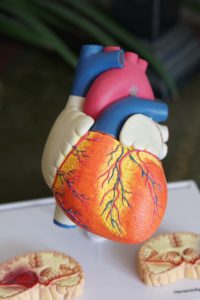Total Therapy Blog

Cardiovascular Disease and Exercise – Part 1
 This article was written by our Kinesiologist, Katrina Kwai.
This article was written by our Kinesiologist, Katrina Kwai.
Growing up playing multiple sports peaked my interest in health sciences at a young age. Upon completing my bachelors in Kinesiology and spending a year volunteering in Cardiac Rehabilitation, my passion towards helping others has increased. I love motivating and guiding clients towards a healthier and more physically active lifestyle.
Cardiovascular Disease and Exercise – Part 1

What is Cardiovascular Disease? Cardiovascular disease (CVD) is an umbrella term for a class of diseases that involves the heart and blood vessels, and one of the leading causes of death in Canada. Considering the heart muscle is only the size of your fist, it is actually one of the strongest muscles in the body. Think about it! The heart is contracting and relaxing consistently from the time you are 21-28 days old in-utero for the rest of your life. It pumps blood, carrying oxygen and nutrients, to all areas of your body. Arteriosclerosis, coronary heart disease, stroke, hypertension and rheumatic heart disease are only a few of many different types of CVDs. Exercise has been shown to be an effective tool for managing or even preventing many of these conditions. Read on for tips to get you started.
CVD Prevention
The first step toward becoming more physically active is to obtain clearance from your physician if you currently have a heart disease, or are over the age of 45 and have been sedentary for most of your life.
You should also consult your physician if you also have two or more of the risk factors listed below:
- Immediate family member with a heart disease before age 55
- Smoker
- High blood pressure
- Abnormal cholesterol levels
- Sedentary
- Diabetic
- Obesity
Making appropriate physical activity a habit is just one way to affect your CVD risk. Dietary changes, managing mental health and psychological wellbeing can also reduce your risk of developing a CVD. When prescribed and performed correctly, exercise has been shown to have the benefits described below.
Benefits of exercise:
- Improvements in muscle function and strength, making daily tasks easier
- Improvements in the body’s ability to take in and use oxygen
- Increase in good High density lipids (HDL) cholesterol
- Reduction in bad Low density lipids (LDL) cholesterol
- Increases insulin sensitivity (important for those who are diabetic)
- Decrease psychological stress levels, indirectly helps lower heart rate
- Release of endorphins, helps reduce perception of pain
- Improve self-confidence and maintain independence

It can be daunting to begin exercising, especially if you are new to exercise, have trouble getting motivated, or do not have a regular routine to follow. Take advantage of the Kinesiologists at Total Therapy, by setting up a complimentary consultation to discuss your health history and goals, and plan an exercise program that will best suit your needs.
Stay tuned for more practical tips and advice in future articles!
References:
Statistics Canada, 2016. “Leading causes of death, total population, by age group”
https://www150.statcan.gc.ca/t1/tbl1/en/tv.action?pid=1310039401
Statistics Canada, 2010. “Six types of cardiovascular diseases”
American College of Sports Medicine, 2014. “ACSM’s Guidelines for Exercise Testing and Prescription, Ninth Edition”








Follow Us!
& Stay Up To Date
BLOG